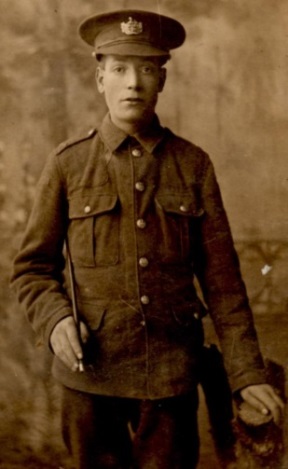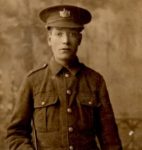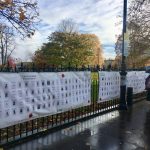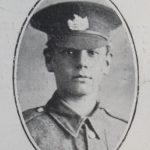Following the Memorial March on 10th November 2018 and WW1 banners displayed along the railings of Montpelier Park we’ve been contacted by some of the relatives of Cheltonians who lost their lives in the First World War. Here Ian Goodridge tells the story of Ernest Davis & Alfred Moon and helps us put a face to the names to ensure they will be remembered.
Whilst clearing my step mother’s house after her death in 2016 I found a photograph of a young man in WWI military uniform and with a Gloucestershire Regiment cap badge. The mount around the picture had images of Lord Kitchener, General French and Admirals Jellicoe and Fisher and there was fading at the top of the mount where mourning bands had rested for some time; from this it was clear that whoever this was he had been killed in the early stages of the Great War. I contacted Brenda a family member who had researched the family tree. Brenda had a press cutting from the Graphic Newspaper of November 6th 1915 titled A Patriotic Family, it showed the 3 sons and 3 sons in law of Mr and Mrs Davis; one of the pictures was an identical copy of the picture I had found and identified the sitter as Ernest Davis 10th Gloucester Regiment, killed in action September 25th 1915. Ernest Davis was the youngest son of Mr and Mrs Davis and was 21 when he was killed in action in France.
This was a surprise to me as my step mother’s maiden name was Moon so I had expected the picture to have come from the paternal side of the family. Further research with Brenda of the family tree both explained the family connection and lead to further revelations of tragedy.
My step mother’s grandmother, Kate Emma Davis, was Ernest older sister. Kate Davis was married to Alfred Charles Moon, Alfred also featured in press cutting from the Graphic as a son in law. He would have been 43 years old at this time and was fighting in France. Alfred was uncle to Alfred Henry Victor James Moon who was killed in action at Gallipoli on the 8th August 1915 aged 18.
Ernest and Alfred grew up on opposite sides of Cheltenham and would never have met but for the marriage, in 1903, of Alfred and Kate. At this time both Ernest and Alfred would have been children Ernest 8 and Alfred 6. We can assume from their relationship to the bride and groom that they would have met at the wedding and on many other family occasions. Sadly both were to meet very similar ends to their short lives and in the space of less than two month of each other, a double tragedy for both the Davis and the Moon family.
Like so many young men of their generation, once family remembrance has been taken to the grave, there is very little left to record their passing. The story of their civilian life, their training, military service and the manner of their deaths can be told only by anecdotes and inference, from census records and regimental war diaries. Nothing can ever be known of the hopes and dreams of these young men and thousand like them whose stories are already lost to history.
Private Ernest Davis (13345) 10th Battalion Gloucestershire Regiment
Private Davis was born in Cheltenham in 1895 the son of Mary Ann and Fred Davis of 1 Brunswick Street, St. Pauls Cheltenham. The 1911 Census recorded him as a Bottle Worker in the local brewery. The Davis’s were a military family, at the time of the Great War Mr. and Mrs. Davis had three sons and three sons in law in the British Army, five of whom were serving in France.
Ernest enlisted with the 10th Battalion Gloucestershire Regiment in September 1914 and left for France disembarking in Le Havre on the 9th August 1915. The Battalion was billeted in Ferfey training for an assault on the German trenches at Loos.
 The 10th Battalion Gloucestershire Regiment at the Battle of Loos
The 10th Battalion Gloucestershire Regiment at the Battle of Loos
At 6:30 on the morning of the 25th September the Battalion formed three lines and began their attack on the German lines under the cover of gas and smoke. The wind was unfavourable and several of the Battalion were affected by the gas; the German wire also proved to be a considerable obstruction. In the smoke direction was not properly maintained so the attack was deflected to the right. Despite heavy resistance the attack was pushed home, assisted by the Cameron Highlands and the Black Watch. The Battalion advanced to the second and third German trenches and into the communication trenches. By nightfall, under heavy rain, some 60 survivors had assembled; this increased to 130 by the third day. Groups of the Battalion’s stragglers and wounded continue to return over the following days so that by the 30th September the ‘ration’ strength had reach a total of 11 officers and 373 other ranks. Ernest was not amongst them and his remains were never found. He was one of 32 Cheltonians to die on the first day of fighting in the Loos offensive.
Ernest is remembered on the Loos Memorial: Dud Corner Cemetery France, Cheltenham Cenotaph and in St. Paul’s Church.
Corporal Alfred Henry Victor James Moon (2117) 7th Battalion Gloucestershire Regiment
Alfred Moon was born in 1897 the son of Henry James and Emily Moon and lived in Upper Norwood Street and later in Bath Road. Nothing is known of his early years; in the 1911 census he is recorded as being still in school. However it can be deduced from his unusual service number that he was in all probability a Special Reservist. A period of previous intensive military training would explain Alfred rank of Corporal at the age of 18.
Alfred enlisted in the 7th (Service) Battalion Gloucestershire Regiment; the Battalion was formed in Bristol in August 1914 as part of Kitchener’s New Army (K1). On the 19th July 1915 the Battalion sailed from Avonmouth and landing, first in Alexandria then moved to Mudros, in preparation for a landing at Gallipoli; the Battalion finally landing in ANZAC Cove between the 3rd and 5th of August.

The 7th Battalion Gloucertershire Regiment at the Battle of Chunuk Bair
At 3 am on the morning of the 8th August the 7th Gloucesters were ordered to form up to the left of the ANZAC Wellington Battalion. The advance started at 4:15 and soon ran into difficult as they were force to file along a mule track in darkness with dugouts to either side. A short while after the advance had started the two left platoon came under enfilade machine gun fire from their left and were practically wiped out. The advance continued for some distance when the ground began to fall away steeply which in conjunction with the continuing enfilade fire caused the companies to wheel into file. About this time a Staff Officer from the Wellingtons made contact to say that the Wellingtons had taken Chunuk Bair and order the Gloucesters to move to the right. The change of direction caused considerable intermixing of Companies and Units. The line formed was under continuous attack by the Turks. In spite of these attacks and heavy loses especially of officers and NCOs the line held until relieved. Every office, CSM and CQMS were either killed or wounded and the Battalion consisted of groups of men commanded by junior NCOs or privates. In total the casualties of the action were 3 officers killed 8 wounded, other ranks 45 killed, 115 wounded and 190 missing.
Alfred’s body was never recovered and he is remembered on the Helles Memorial Turkey, Cheltenham Cenotaph and in St. Philips and St James Church.
Article contributed by Ian Goodridge
(Thanks to Brenda Cove and Joe Devereux – Soldiers of Gloucestershire Museum. Principle sources: Leaving all that was dear – Cheltenham and the Great War J Devereux and G Sacker, War Diaries of the 7th and 10th Gloucestershire Battalions)



Leave a Reply